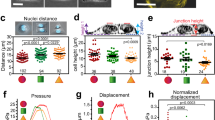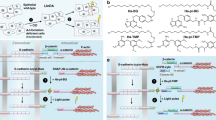Abstract
Mechanical forces between cells have a principal role in the organization of animal tissues. Adherens junctions are an important component of these tissues, connecting cells through their actin cytoskeleton and allowing the assembly of tensile structures1,2,3,4. At least one adherens junction protein, β-catenin, also acts as a signalling molecule, directly regulating gene expression5,6,7. To date, adherens junctions have only been detected in metazoa, and therefore we looked for them outside the animal kingdom to examine their evolutionary origins. The non-metazoan Dictyostelium discoideum forms a multicellular, differentiated structure8. Here we describe the discovery of actin-associated intercellular junctions in Dictyostelium. We have isolated a gene encoding a β-catenin homologue, aardvark, which is a component of the junctional complex, and, independently, is required for cell signalling. Our discovery of adherens junctions outside the animal kingdom shows that the dual role of β-catenin in cell–cell adhesion and cell signalling evolved before the origins of metazoa.
This is a preview of subscription content, access via your institution
Access options
Subscribe to this journal
Receive 51 print issues and online access
$199.00 per year
only $3.90 per issue
Buy this article
- Purchase on Springer Link
- Instant access to full article PDF
Prices may be subject to local taxes which are calculated during checkout





Similar content being viewed by others
References
Stevenson, B. R. & Paul, D. L. The molecular constituents of intercellular junctions. Curr. Opin. Cell Biol. 1, 884–891 ( 1989).
Ozawa, M., Ringwald, M. & Kemler, R. Uvomorulin–catenin complex formation is regulated by a specific domain in the cytoplasmic region of the cell adhesion molecule. Proc. Natl Acad. Sci. USA 87, 4246– 4250 (1990).
Ozawa, M., Baribault, H. & Kemler, R. The cytoplasmic domain of the cell adhesion molecule uvomorulin associates with three independent proteins structurally related in different species. EMBO J. 8, 1711– 1717 (1989).
Nagafuchi, A. & Takeichi, M. Cell binding function of E-cadherin is regulated by the cytoplasmic domain. EMBO J. 7, 3679–3684 (1988).
Behrens, J. et al. Functional interaction of β-catenin with the transcription factor LEF–1. Nature 382, 638– 642 (1996).
Molenaar, M. et al. XTcf-3 transcription factor mediates β-catenin-induced axis formation in Xenopus embryos. Cell 86, 391–399 (1996).
Huber, O. et al. Nuclear localization of β-catenin by interaction with transcription factor LEF-1. Mech. Dev. 59, 3– 10 (1996).
Raper, K. B. Dictyostelium discoideum, a new species of slime mold from decaying forest leaves. J. Agr. Res. 50, 135– 147 (1935).
Pang, K. M., Lee, E. & Knecht, D. A. Use of a fusion protein between GFP and an actin-binding domain to visualize transient filamentous-actin structures. Curr. Biol. 8, 405–408 ( 1998).
Nathke, I. S., Hinck, L., Swedlow, J. R., Papkoff, J. & Nelson, W. J. Defining interactions and distributions of cadherin and catenin complexes in polarized epithelial cells. J. Cell Biol. 125, 1341–1352 (1994).
Morio, T. et al. The Dictyostelium developmental cDNA project: generation and analysis of expressed sequence tags from the first-finger stage of development. DNA Res. 5, 335–340 (1998).
Altschul, S. F. et al. Gapped BLAST and PSI-BLAST: a new generation of protein database search programs. Nucleic Acids Res. 25, 3389–3402 (1997).
Aberle, H., Schwartz, H., Hoschuetzky, H. & Kemler, R. Single amino acid substitutions in proteins of the armadillo gene family abolish their binding to α-catenin. J. Biol. Chem. 271 , 1520–1526 (1996).
Wang, Y. X., Catlett, N. L. & Weisman, L. S. Vac8p, a vacuolar protein with armadillo repeats, functions in both vacuole inheritance and protein targeting from the cytoplasm to vacuole. J. Cell Biol. 140, 1063– 1074 (1998).
Fleckenstein, D., Rohde, M., Klionsky, D. J. & Rüdiger, M. Yel013p (Vac8p), an armadillo repeat protein related to plakoglobin and importin-α, is associated with the yeast vacuole membrane. J. Cell Sci. 111, 3109–3118 (1998).
Pan, X. & Goldfarb, D. S. YEB3/VAC8 encodes a myristylated armadillo protein of the Saccharomyces cerevisiae vacuolar membrane that functions in vacuole fusion and inheritance. J. Cell Sci. 111, 2137–2147 ( 1998).
Williams, J. G. et al. Origins of the prestalk-prespore pattern in Dictyostelium development. Cell 59, 1157– 1163 (1989).
Harwood, A. J., Plyte, S. E., Woodgett, J., Strutt, H. & Kay, R. R. Glycogen synthase kinase 3 regulates cell fate in Dictyostelium. Cell 80, 139–148 (1995).
Plyte, S. E., O'Donovan, E., Woodgett, J. R. & Harwood, A. J. Glycogen synthase kinase-3 (GSK-3) is regulated during Dictyostelium development via the serpentine receptor cAR3. Development 126, 325–333 (1999).
Sokol, S. Y. Wnt signaling and dorso-ventral axis specification in vertebrates. Curr. Opin. Genet. Dev. 9, 405–410 (1999).
Rocheleau, C. E. et al. Wnt signaling and an APC-related gene specify endoderm in early C. elegans embryos. Cell 90, 707–716 (1997).
Schlesinger, A., Shelton, C. A., Maloof, J. N., Meneghini, M. & Bowerman, B. Wnt pathway components orient a mitotic spindle in the early Caenorhabditis elegans embryo without requiring gene transcription in the responding cell. Genes Dev. 13, 2028–2038 ( 1999).
Korswagen, H. C., Herman, M. A. & Clevers, H. C. Distinct β-catenins mediate adhesion and signalling functions in C. elegans. Nature 406, 527–532 (2000).
Manstein, D. J., Schuster, H. P., Morandini, P. & Hunt, D. M. Cloning vectors for the production of proteins in Dictyostelium discoideum . Gene 162, 129–134 (1995).
Howard, P. K., Ahern, K. G. & Firtel, R. A. Establishment of a transient expression system for Dictyostelium discoideum. Nucleic Acids Res. 16 , 2613–2623 (1988).
Strafstrom, J. & Steahelin, L. Antibody localisation of extensin in cell walls of carrot storage roots. Planta 174, 321–332 ( 1988).
Kim, L., Liu, J. & Kimmel, A. R. The novel tyrosine kinase ZAK1 activates GSK3 to direct cell fate specification. Cell 99, 399– 408 (1999).
Acknowledgements
We thank A. Staehelin, who suggested that we examine the stalk pinch region for an actin ring. We would also like to thank R. Williams and E. Dalton for their help with making DNA constructs; and D. Knight, V. Braga, R. Kay and J. Hyams for their advice and comments. J.C.C. was supported by a MRC/GlaxoWellcome Studentship. J.P.R. is a Wellcome Prize Student and A.J.H. is a Wellcome Trust Senior Fellow. This work was partly funded by a NATO collaborative research grant, the research enhancement fund of the College of Arts and Sciences, Texas Tech University, and departmental and university funds to the Department of Biological Sciences Electron Microscopy Laboratory at Texas Tech University.
Author information
Authors and Affiliations
Corresponding author
Supplementary information
Rights and permissions
About this article
Cite this article
Grimson, M., Coates, J., Reynolds, J. et al. Adherens junctions and β-catenin-mediated cell signalling in a non-metazoan organism. Nature 408, 727–731 (2000). https://doi.org/10.1038/35047099
Received:
Accepted:
Issue Date:
DOI: https://doi.org/10.1038/35047099
This article is cited by
-
Constitutive activation of β-catenin in odontoblasts induces aberrant pulp calcification in mouse incisors
Journal of Molecular Histology (2021)
-
Diverse cell junctions with unique molecular composition in tissues of a sponge (Porifera)
EvoDevo (2019)
-
Metazoan evolution of the armadillo repeat superfamily
Cellular and Molecular Life Sciences (2017)
-
The origin and evolution of cell types
Nature Reviews Genetics (2016)
-
Classification and expression analyses of homeobox genes from Dictyostelium discoideum
Journal of Biosciences (2015)
Comments
By submitting a comment you agree to abide by our Terms and Community Guidelines. If you find something abusive or that does not comply with our terms or guidelines please flag it as inappropriate.



